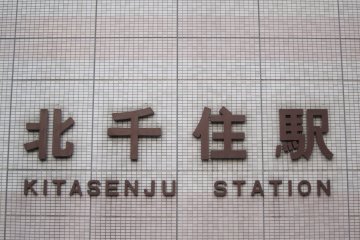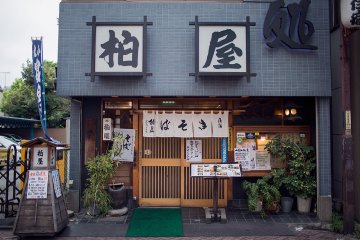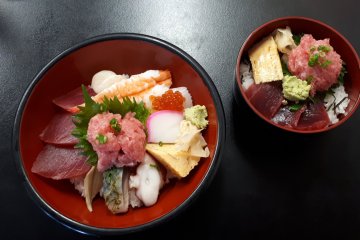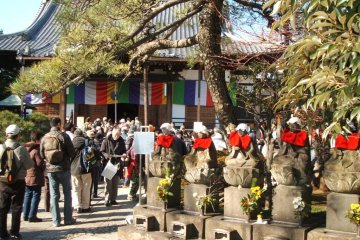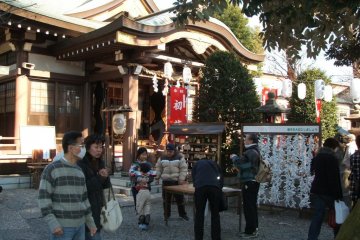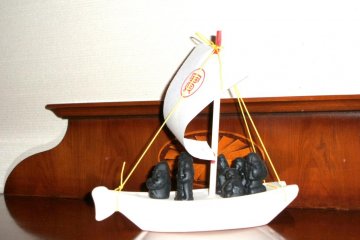If you're in Japan during the New Year season an interesting day can be spent making a "pilgrimage tour" to the shrines and temples to gather your collection of the 7 lucky gods. The lucky god statuettes are sold at the various shrines and temples you'll visit on this tour. Be sure to pick up the little boat too. After all, your 7 little gods need some sort of transport.
There are several such tours available around Tokyo. One of the better walks starts at Horikiri train station on the Tōbu Isesaki Line. From there set off on your course along the Sumida River to find those seven little friends who are going to bring you good fortune and good luck in the new year. There are signs along the way (in Japanese) pointing you to the next temple or shrine. Or, just follow the groups of other "pilgrims" making the same tour. You can also ask people along the way - in Japan, it's not hard to find some kind soul who will give you direction.
The pilgrimage trail outlined below was devised in 1804 by Sawara Kiku, a retired curio dealer. He was a man who liked to dabble in Chinese culture. Sawara owned land in the vicinity that he had turned into a garden, Hyakkaen. He installed a small statue of the Chinese deity Fukurokuju. Once this task was completed he searched the temples and shrines in the vicinity to complete the set of the lucky seven gods and so the pilgrimage was born.
1. Tamon Temple
Stop one is at the Tamon Temple (Tamonji). Tamon is another name for Bishamon, the first of the statuettes you can buy, and the Lucky Deity of this temple. Bishamon/Tamon is known as a protector of Buddhism from evil forces and he also serves as the guardian of the other six Deities of Good Fortune. Tamonji Temple stands in the northern part of Mukojima, which means the "Side Yonder of the River," and therefore acts as the protector of the area. The temple sports a nice thatched gate, the only one left in the whole of the metropolis.
2. Shirahige Jinja
The next stop is Shirahige Jinja (White Whiskers Shrine), where you can buy Jurojin, the deity of longevity. Shirahige is a deity of Korean origin. However, he is not one of the 7 gods of good fortune, but like Jurojin he sports a long white beard so the two are easily associated with each other. Jurojin was originally a Chinese god of longevity and he also carries a long staff and is dressed in the clothes of a scholar.
3. Hyakkaen
From there head for Hyakkaen (of Mr. Sawara Kiku fame, noted above). The garden area covers about 3 acres and the plants and flowers of the garden were all selected based on association with Chinese literature. This is because of the Chinese centered interests during the Edo period, which was the era when this garden was completed. There is a small shrine in the garden dedicated to Fukurokuju, the Chinese deity of Good Luck, Fortune and Long Life.
4. Chomeiji Temple
Then, on to Chomeiji, the temple of long life and the home of Benten, the only female of the 7 lucky gods. Benten is the deity of music and fine arts. She is not of Chinese origin, but harks back to an Indian water sprite. Chomeiji also has a link with water and there is a sacred spring on the grounds. It is purported that the water from this spring cured Iemitsu, who was the third Tokugawa Shogun (war lord) of a stomach ailment. Drink the water if you like, so the old tummy will be in great shape for all the New Year food you'll be enjoying.
5. Kofukuji
A short 50 meters from Chomeiji puts you at Kofukuji, a Chinese style temple that was founded in 1673 although the present day buildings were done in 1933 after the destruction of the 1923 earthquake. This temple houses Hotei, the jolly Chinese priest with a huge belly and a big smile. Hotei is the god of happiness and contentment. He dispenses gifts from his treasure bag - sort of the Chinese Santa Claus!
6. & 7. Mimeguri Jinja
You're almost there - the last stop on the pilgrimage -which is Mimeguri Jinja. Mimeguri was founded in the 14th century, but its history goes even further back. However, the central structure that stands there today was built in 1850. This shrine possesses two of the 7 lucky gods. Ebisu is the patron of fishermen, commerce, and good fortune and carries a fishing rod as well as his catch, a large sea bream. Daikoku, the god of wealth, farmers, and the kitchen is a mingling of an Indian god and the Japanese Okuninushi. He stands on rice bales and carries a mallet that he uses to scatter money around. Both gods are very cheerful and extremely popular in Japan.
Now you have your 7 gods and you should also have the boat, which is the 7 gods treasure craft that they sail into the harbor every New Year's eve.



